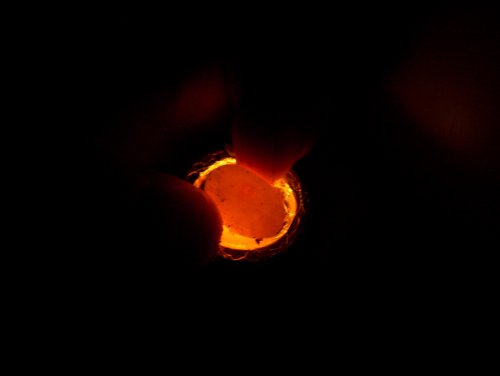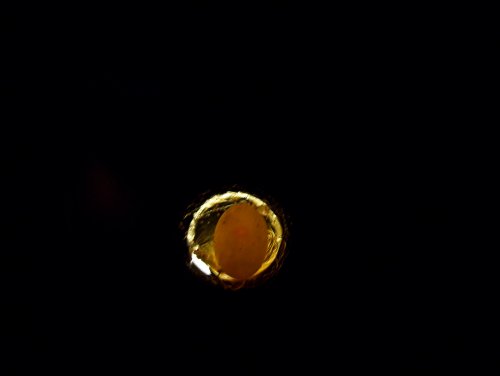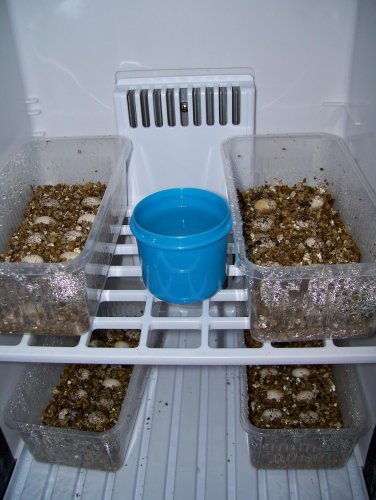Navigation
Install the app
How to install the app on iOS
Follow along with the video below to see how to install our site as a web app on your home screen.
Note: This feature may not be available in some browsers.
More options
You are using an out of date browser. It may not display this or other websites correctly.
You should upgrade or use an alternative browser.
You should upgrade or use an alternative browser.
fertile egg photos?
- Thread starter AFH
- Start date
Hi,
I have monitored my eggs (F. pardalis) since they were laid last spring and I'd just like to mention that all of them started out looking pure yellow when candled. They were white on the outside (not yellow looking on the outside like inferts), but when candled in the dark they were pure yellow with no signs of blood vessles. I was a bit concerned at first, but as the months went on and the temps gradually rose, and diapause was broken, they became pink when candled. Now I can see blood vessles when I look close, but mostly its just pink looking with a dark red spot in there. The first clutches have been hatching these last few weeks, so I know they are/were good eggs.
I would try for pics, but honestly it would be kinda tough in the dark with the little eggs...
Hope this helps a bit.
- Joe
I have monitored my eggs (F. pardalis) since they were laid last spring and I'd just like to mention that all of them started out looking pure yellow when candled. They were white on the outside (not yellow looking on the outside like inferts), but when candled in the dark they were pure yellow with no signs of blood vessles. I was a bit concerned at first, but as the months went on and the temps gradually rose, and diapause was broken, they became pink when candled. Now I can see blood vessles when I look close, but mostly its just pink looking with a dark red spot in there. The first clutches have been hatching these last few weeks, so I know they are/were good eggs.
I would try for pics, but honestly it would be kinda tough in the dark with the little eggs...
Hope this helps a bit.
- Joe
davider
Avid Member
Does anyone have a picture of what fertile eggs look like when you shine a light on them?
I read they're supposed to be white with blood vessels and infertile are just yellow. I'd like to see what a good egg looks like.
AFH
Not too great of a photo but here you go...hope it helps.
David

AFH
Avid Member
Thanks, guys.
One of my veileds has had 2 clutches, from the same sire. The first one was completely infertile (I didn't let them mate long enough).
But the second, I left them together until she turned gravid colored and wanted nothing to do with him. Yet this clutch looked just the same as the other one. I am begining to wonder if one if sterile . Some of the new clutch already went bad, but they were small. The large ones seem to be doing okay. Maybe they are good
. Some of the new clutch already went bad, but they were small. The large ones seem to be doing okay. Maybe they are good  .
.
One thing I did learn in my research was never get rid of an egg until you're sure.
AFH
One of my veileds has had 2 clutches, from the same sire. The first one was completely infertile (I didn't let them mate long enough).
But the second, I left them together until she turned gravid colored and wanted nothing to do with him. Yet this clutch looked just the same as the other one. I am begining to wonder if one if sterile
One thing I did learn in my research was never get rid of an egg until you're sure.
AFH
Jeweledchameleons
Avid Member
what's cooking?
There are lots of things that can go wrong.
I lost my first 4+ clutches due to a previous "unknown" illl defined set of problems.
all that I knew was that 'everything would fungal over" dead.
I've recently just figured out what the underlying issue was...
after several successful hatches I had a flash of reflective insight.
I'm a culinary freak and enjoy preparing good food at the home
as well as growing what I can ... after all... fresh is best.
store bought stuff is often inferior or "bad" for the table.
These fresh items have included different species of medicinal / culinary mushrooms
some I kept fruiting in the kitchen to pick as needed.
(yes, I realize that it may seem weird to some.. but it's actually "geeky fun")
anyhoo... The problem was with the spores from the oyster species going airborn (go figure huh?)
and then making their way into the incubators and or contaminating the female's clutch directly
when she was egg laying as her cage was close to the kitchen.
Oysters produce massive amounts of spores that don't usually cause a problem for us humans
they're invisible to the eye when airborn even in the millions and like I said
they're normally not a problem for people and pets
but for a tight little protein and carbo package kept in ideal and humid conditions....
it was fungal heaven...
Even store bought oysters (Pleurotus sp. are an aggressive family of fungi)
will be releasing spores. (FYI)
needless to say... no more oysters for this breeder...
well.... mostly, no oysters...
I still love the King oysters but now I'm taking measures
to keep the incubation rooms decontaminated from what's cooking.
Just goes to show that problems can arise from unexpected sources.
Lots of things can go wrong and after all the obvious stuff is addressed
there may still be something you're missing right under your nose.
There are lots of things that can go wrong.
I lost my first 4+ clutches due to a previous "unknown" illl defined set of problems.
all that I knew was that 'everything would fungal over" dead.
I've recently just figured out what the underlying issue was...
after several successful hatches I had a flash of reflective insight.
I'm a culinary freak and enjoy preparing good food at the home
as well as growing what I can ... after all... fresh is best.
store bought stuff is often inferior or "bad" for the table.
These fresh items have included different species of medicinal / culinary mushrooms
some I kept fruiting in the kitchen to pick as needed.
(yes, I realize that it may seem weird to some.. but it's actually "geeky fun")
anyhoo... The problem was with the spores from the oyster species going airborn (go figure huh?)
and then making their way into the incubators and or contaminating the female's clutch directly
when she was egg laying as her cage was close to the kitchen.
Oysters produce massive amounts of spores that don't usually cause a problem for us humans
they're invisible to the eye when airborn even in the millions and like I said
they're normally not a problem for people and pets
but for a tight little protein and carbo package kept in ideal and humid conditions....
it was fungal heaven...
Even store bought oysters (Pleurotus sp. are an aggressive family of fungi)
will be releasing spores. (FYI)
needless to say... no more oysters for this breeder...
well.... mostly, no oysters...
I still love the King oysters but now I'm taking measures
to keep the incubation rooms decontaminated from what's cooking.
Just goes to show that problems can arise from unexpected sources.
Lots of things can go wrong and after all the obvious stuff is addressed
there may still be something you're missing right under your nose.
Fertile Chamelen eggs
Hi, I thought i'd post my photos to help people recognise fertile eggs at quite an early stage...
If you have retrieved the eggs as they had been layed you should see the signs of a fertile egg quite easily...try to make sure they go into the incubator in the same position as they were deposited.
As you can see in the photos, the top of the egg has a red spot, this is no bigger than 2-3mm in diameter...this is were the pink/red veigns come from that everyone talks about, without this you don't have the basis of a fertile egg.
Without going into much detail 'I will save it maybe for later' I've found that if you give the male long enough to do his bit..'''you will know how long is enough as the female has nothing to do with him after he's contributed enough''' and gather the eggs up and place in the incubating material as layen, have sufficient incubating equipment for a lengthy period, a lot of patience and are able to check every other day for temp/humidity and overall egg condition you really can't go wrong
I am new to this forum so anything I've posted which people don't aggree to please let me know..
I have been breeding Yemens for some time now so any advice I can give I will be more than willing.
THE EGGS IN THE PICTURES WRE ALL LAYED 4.5 WEEKS AGO
Hi, I thought i'd post my photos to help people recognise fertile eggs at quite an early stage...
If you have retrieved the eggs as they had been layed you should see the signs of a fertile egg quite easily...try to make sure they go into the incubator in the same position as they were deposited.
As you can see in the photos, the top of the egg has a red spot, this is no bigger than 2-3mm in diameter...this is were the pink/red veigns come from that everyone talks about, without this you don't have the basis of a fertile egg.
Without going into much detail 'I will save it maybe for later' I've found that if you give the male long enough to do his bit..'''you will know how long is enough as the female has nothing to do with him after he's contributed enough''' and gather the eggs up and place in the incubating material as layen, have sufficient incubating equipment for a lengthy period, a lot of patience and are able to check every other day for temp/humidity and overall egg condition you really can't go wrong
I am new to this forum so anything I've posted which people don't aggree to please let me know..
I have been breeding Yemens for some time now so any advice I can give I will be more than willing.
THE EGGS IN THE PICTURES WRE ALL LAYED 4.5 WEEKS AGO
Attachments
Chameleons Canada
Avid Member
Wow,
Excellent contribution man! Thanks a lot.
Excellent contribution man! Thanks a lot.
Cainschams
New Member
Great post Gaza!
Thats what my eggs look like also when I candled them. Dont do it to many though because Im pretty sure all the ones I took out to candle didnt make it as if I didnt place it back in the right position. Im sure these will be just fine. My female laid her fist clutch that I thought were fertile but then they all died. They looked exactly like the ones that where fertile. White and robust.
Thats what my eggs look like also when I candled them. Dont do it to many though because Im pretty sure all the ones I took out to candle didnt make it as if I didnt place it back in the right position. Im sure these will be just fine. My female laid her fist clutch that I thought were fertile but then they all died. They looked exactly like the ones that where fertile. White and robust.
Sorry I forgot to mention that!! I only check around 10 % of my eggs to see if they are fertile I never check anymore than that as I don't feel it necessary.. I've never had the problem of eggs 'not' hatching due to a quick examination but then again there's always a first!
Just a quick note that I'd like to add whhich I hadn't earlier is that I have never thrown an egg out or discarded a batch because it didn't look as though it were fertile, If your going to inncubate the rest you may aswell keep that one and sometimes they turn out to be fertile after all...so don't give up hope!
Just a quick note that I'd like to add whhich I hadn't earlier is that I have never thrown an egg out or discarded a batch because it didn't look as though it were fertile, If your going to inncubate the rest you may aswell keep that one and sometimes they turn out to be fertile after all...so don't give up hope!
Chameleon Nation
Avid Member
Candeling
This is a pic of a fertile Veiled chameleon egg at 5 months incubation time. You can clearly see the tail and back leg.
This is a pic of a fertile Veiled chameleon egg at 5 months incubation time. You can clearly see the tail and back leg.
Last edited:





